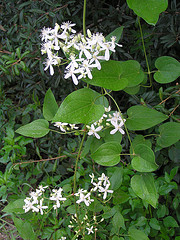

Your plant will change color in this instance, beginning to turn yellow or white, much like it does on us. It is simple to determine whether your Sweet autumn clematis (your Clematis terniflora) has sunburn. As it progresses, yellowing moves outward, eventually reaching young leaves, too. Nitrogen deficiency shows up as a general yellowing.Older leaves show the symptoms initially, and the leaf edges quickly darken. Insufficient potassium causes the leaf edges to turn brilliant yellow while the interior of the leaf stays green.The newest leaves are first affected by sulfur deficiency, rendering them completely yellow.Another indicator of iron deficiency is yellowing between leaf veins, but young leaves on plant tops and branch tips are first affected.Veins continue to be green while the leaf’s core turns yellow. Yellow patches between leaf veins on elder leaves are the first sign of magnesium shortage.Here are some indicators of yellowing on the Clematis terniflora brought on by its numerous flaws:
#Clematis terniflora leaves how to#
When it’s overwatering, simply reduce your watering frequency, and if you think it’s a nutrient deficiency, here’s how to check it: The two main causes of this problem are overwatering and a lack of nutrition. In the world of horticulture, yellowing leaves are undoubtedly the most common problem. Why are my Sweet autumn clematis leaves turning yellow? This sort of sickness is one of the most aggravating for Sweet autumn clematis owners. We provide you with all the information you need to identify and save your plants if they display signs like leaves that suddenly change color or wilt/droop. Why does my Sweet autumn clematis have leaf spots? We advise you to remove the infected parts of the plant, cut off the infected roots and leaves, then repot your plant using sterile potting soil and a clean pot.

Most of the time, it is due to overwater of the Clematis terniflora. The solution is quite logical when you know the cause of the problem. Don’t ignore these symptoms, as they may end up killing your plant. If you notice brown (or gray) spots, it is probably this fungus. Gray mold spots are a type of fungus that is found a lot in flowers, and spreads quite rapidly. Why does my Sweet autumn clematis have gray mold spots? For this reason, if the symptoms appear, we highly advise that you adhere to our recommendations to keep your plant alive: Blackened and softened roots. If left untreated, root rot on your Sweet autumn clematis (Clematis terniflora) can be fatal. Why does my Clematis terniflora roots have rot? Humans and pets are at risk from this plant.

It’s considered an invader in many eastern parts of the United States because of the aggressive growth of sweet autumn clematis. The spent flowers are replaced by fuzzy seed heads that are also attractive. When covering wood fences or similar structures, a sweet autumn clematis in bloom gives the appearance of fleece. The flowers are small, white, and fragrant. The twining vine has leaves that are shiny and dark green. It is gaining a few feet in length every year. It can grow to 30 feet, but 15 feet is more typical of a mature size. In the late summer and early fall, clematis produces fragrant flowers that are sweet and fragrant. NOTE: In this article, Sweet autumn clematis and Clematis terniflora may be used interchangeably in fact, Clematis terniflora is the botanical name for Sweet autumn clematis.


 0 kommentar(er)
0 kommentar(er)
